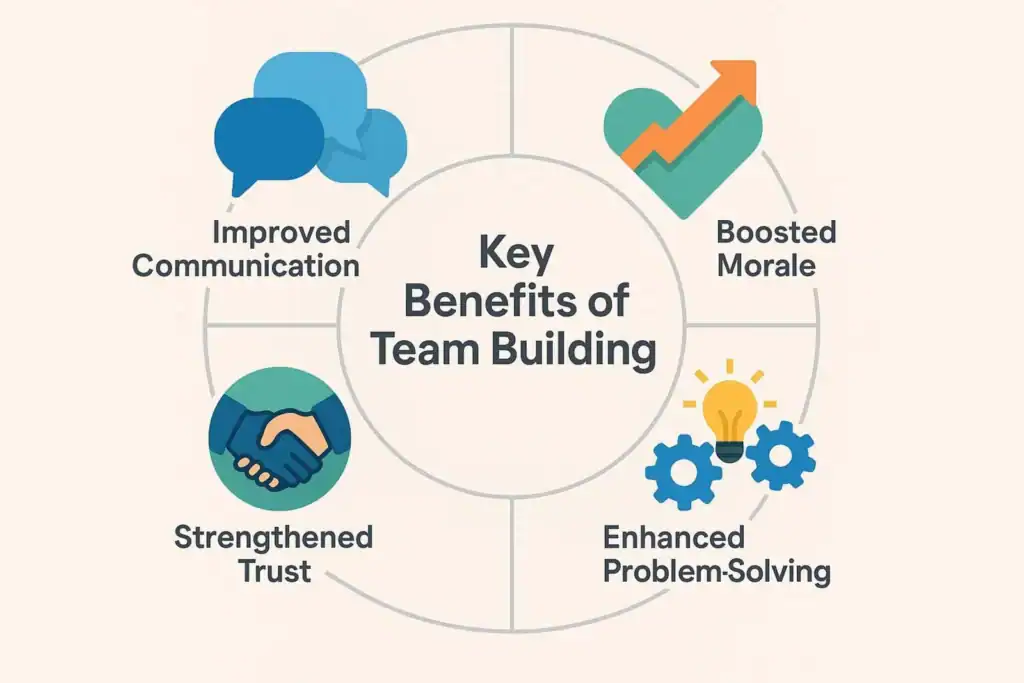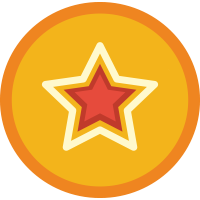Team building games are more than a quick break from work. These planned activities help people work better together, build trust, and understand each other. They turn a group of coworkers into a strong, connected team ready to handle tough tasks. By creating a friendly, hands-on space, team games support a calmer, more productive workplace.
Their value goes well beyond fun. The right activities improve how people talk to each other, lift morale, and build problem-solving skills. They let coworkers connect in new ways, uncover strengths, and build a shared sense of purpose that day-to-day tasks often don’t create.
What Are Team Building Games for Work?
Team building games are structured activities with a clear goal: help a group work better together. They are not random time-fillers. Each game is chosen to support key team skills like communication, collaboration, trust, and problem-solving. The best part is they make learning feel easy and enjoyable, so people grow in a relaxed setting.
From quick icebreakers to bigger challenges, the aim stays the same: build a stronger, more connected team. These games give people a chance to step outside their roles, talk more openly, and appreciate each other’s strengths. In short, they are an investment in people, because a connected team supports business success.
How Do Team Building Games Benefit Workplace Culture?
Team games add fun and friendship to the workday, whether your team meets online or in person. They break down barriers and help people connect on a human level. When coworkers feel known and respected, they stay engaged and help create a kinder, more open workplace.
This effect spreads across the company. Teams that make time for team building see higher engagement, better productivity, and higher job satisfaction. Happier teams work better together, feel less stressed, and stay longer, which saves hiring costs and helps the business run smoothly.
What Is the Difference Between Team Building and Team Bonding Activities?
People often mix the two, but there is a small difference. Team building activities are structured and aim to improve skills like communication, problem-solving, and planning. They are built to improve how a team works and often focus on real workplace needs. Think of them as training wrapped in fun.
Team bonding activities are more casual and focus on social connections and friendship. They help people know each other better and feel like part of a group. While they can help with trust and communication, the main goal is connection and enjoyment. Both matter for a healthy team, and each serves a slightly different purpose.
Benefits of Team Building and Games at Work
Bringing team games into work does more than entertain. These activities help build a strong, steady, and responsive team. When people share experiences, they learn to work together, support each other, and do their best work.
Spending time on these activities shows care for employee growth and well-being. That builds loyalty and lowers turnover. The benefits reach everyday tasks and long-term goals. You’re building trust, shared understanding, and common goals that help teams do great work.

Improves Communication and Collaboration
Good communication is the base of any strong team, and team games help people practice this important skill. Activities that involve passing messages, describing objects without naming them, or solving puzzles as a group make people listen carefully and explain clearly. This helps teammates learn different styles and adjust their own.
These games also naturally build collaboration. When the group works toward one goal, people combine strengths, respect different views, and coordinate their efforts. Skills learned in low-pressure games carry into real projects, leading to smoother teamwork and better ideas.
Boosts Employee Morale and Motivation
Happy teams are often more productive. Team games lift mood and motivation. A short, fun break can reduce stress and bring energy back to the day. People feel better about their work and coworkers.
When employees feel valued and enjoy time with the team, job satisfaction rises. This leads to stronger engagement and loyalty. A simple thank-you or reward for joining in can reinforce the habit and keep team spirit high.
Improves Problem-Solving and Creativity
Many team games challenge people to solve problems and think creatively. Activities like the Marshmallow Challenge or escape rooms push teams to test ideas, plan under time limits, and find new solutions with limited tools. These settings are safe places to try, fail, learn, and try again.
By mixing viewpoints and encouraging group ideas, these games help teams approach hard problems from different angles. People discover strengths in analysis and imagination. Over time, this boosts everyday problem-solving and innovation.
Strengthens Trust and Workplace Relationships
Trust holds a team together, and team games help build it. Activities that use blindfolds or rely on spoken directions make people depend on each other. Shared moments of support and care build confidence among coworkers.
These games also deepen relationships. Non-work chats help teammates learn about each other’s humor, interests, and quirks. This leads to more natural conversations and a stronger, kinder team overall.
Reduces Stress and Prevents Burnout
Work can be demanding, and long-term stress can lead to burnout. Team games offer a helpful reset by giving people time to laugh and relax.
These breaks support mental health. A positive team setting helps people feel less alone and more supported. Teams that play together regularly handle stress better and create a healthier work-life balance.
Categories of Team Building Games for Employees
Team games come in many types. Knowing the categories helps you choose activities that fit your team’s needs. Some games break the ice, others build thinking skills, and some focus on creativity or movement. Match the activity to your goals and your team’s comfort level.
Whether your team is remote, in the office, or hybrid, you can find options that work well. The list below makes selection simpler and keeps activities useful and enjoyable.
| Category | Typical Time | Best For | Examples |
|---|---|---|---|
| Icebreakers | 5-15 minutes | New or mixed teams | Two Truths and a Lie, One Word |
| Problem-Solving | 20-60 minutes | Thinking under pressure | Puzzles, Marshmallow Challenge |
| Creative & Collaborative | 30-60 minutes | Idea sharing and team output | Storytelling, group builds |
| Physical & Outdoor | 30-90 minutes | Energy and trust | Scavenger hunt, obstacle course |
| Virtual | 15-60 minutes | Remote teams | Online trivia, digital Pictionary |
| Office-Based | 10-30 minutes | In-office breaks | Office Bingo, Blind Drawing |
Icebreaker Games for New and Existing Teams
Icebreakers are a great start for any team effort, whether you’re welcoming new people or adding energy to a long-standing group. These games help with intros, lighten the mood, and make people feel ready to join in.
For new teams, they speed up getting to know each other beyond job titles. For existing teams, they reveal new sides of coworkers and spark fresh chat. Simple and fun, icebreakers help build a friendly, talkative team culture.
Problem-Solving and Critical Thinking Games
If you want sharper thinking, problem-solving games are a strong pick. They ask teams to use logic, plan steps, and try creative moves. You might see puzzles, riddles, or building tasks with limited supplies.
These games build fast decision-making and creative thinking. They show how people approach problems differently and how a group can outperform one person. Regular practice makes teams quicker and more inventive with real work problems.
Creative and Collaborative Activities
These activities bring out the team’s imagination while stressing group effort. They might include art, storytelling, or making something together where every role matters. Examples: group murals, chain-reaction machines, or pitching a product idea for a random office item.
The main benefit is a space where all ideas get a chance. People from different roles can mix skills and create something bigger than any one person could. This builds creativity, communication, and mutual respect.
Physical and Outdoor Team Challenges
Getting outside or moving together can be a great change of pace. Outdoor games add energy and teamwork in a new setting. Options include scavenger hunts, Earth-ball, obstacle courses, or geocaching.
These challenges build leadership, trust, and communication in a physical context. Teams often rely on signals, plan moves, and push past limits together. Shared wins outside the office can strengthen bonds and lower stress.
Virtual Team Building Games for Remote Teams
With more remote work today, virtual team games are important for keeping people connected. These use video calls and online tools to create shared experiences across locations. Popular picks include online trivia, digital Pictionary, virtual escape rooms, and Show and Tell.
Virtual games fight isolation, support remote teamwork, and build community. Hold them during work hours so more people join. Remote teammates should feel just as included as those in the office.
Office-Based Group Games
If your team is in the office, many games work right at desks or in shared areas. They are easy to set up and fit into short breaks. Examples: Office Bingo, Two Truths and a Lie, Blind Drawing, or the Marshmallow Challenge.
These spark quick thinking and lift morale without leaving the workplace. They promote friendly competition and cross-team chats, creating a lively office vibe.
Popular and Effective Team Building Games for Work
Team building offers many game options. Some are quick and simple, others require more coordination. Picking the right one can improve how your team connects. Below, we look at widely used choices and what they bring to a workplace.
These games engage people, spark collaboration, and create moments that stick. Whether you want a calm activity or a high-energy challenge, you can find a fit for your team size, goals, and setting.
Two Truths and a Lie
This classic icebreaker helps teammates learn fun facts about each other. Each person shares three statements: two true and one false. The group guesses the false one. Plan for 2-3 minutes per person; works well with groups of 3 or more.
Beyond fun, it builds listening and challenges assumptions. It’s also great for quieter team members, giving them a clear turn to share without pressure.
Scavenger Hunt
Scavenger hunts encourage cooperation and creative thinking. Teams hunt for items, solve clues, or finish tasks within a time limit. You can theme them around office facts, company history, or local spots.
They work for small or large groups and push teams to communicate, plan, and split tasks. Remote-friendly versions can use online clues or web searches. The mix of teamwork and friendly competition makes this a standout choice.
Office Trivia or Quiz Challenges
Trivia adds a playful way to test knowledge. Topics can include general facts, pop culture, company info, industry topics, or fun teammate facts. Use it as a warm-up or host a full trivia session.
Trivia prompts teamwork in small groups as people combine knowledge. It’s uplifting, offers a mental reset, and helps teammates learn about each other. Tools like Kahoot or Jackbox work well for remote sessions.
Human Knot
Human Knot builds teamwork, communication, and patience while getting people moving. Participants stand in a circle, grab hands with two different people (not next to them), and form a “knot.” The goal: untangle into a circle without letting go.
Best for 8-16 people; plan for 20-30 minutes. It calls for clear directions, careful movement, and group problem-solving. You’ll see different leadership styles emerge as the team works through a tricky setup together.

Marshmallow Challenge
Teams get 20 sticks of spaghetti, one yard of tape, one yard of string, and one marshmallow. Build the tallest freestanding structure with the marshmallow on top in about 18-20 minutes.
This tests teamwork under pressure and shows the value of quick prototypes and steady iteration. It highlights planning, learning fast, and trying new ideas before time runs out.
Blind Drawing
In pairs, two people sit back-to-back. One describes a picture without using the object’s name; the other draws based only on the description. No peeking.
Plan for 5-10 minutes; good for groups of 4 or more. It shows how easily directions can be misunderstood and why clear language and active listening matter.
Escape Room or Puzzle Solving
Escape rooms and puzzle sets are immersive group challenges. Teams solve clues, riddles, and locks to reach a goal within a time limit. You can visit a venue or set up a version at the office.
These activities rely on shared brainpower and varied skills. Teams observe, share info, think critically, and communicate to move forward. They support quick decisions, planning, and calm under pressure-and the shared win brings people closer.
Charades and Pictionary
Charades uses acting without words; Pictionary uses drawing. Teammates guess the word or phrase.
Both are flexible and can run in person or online. They build non-verbal communication, creativity, and quick thinking. Misreads are funny, wins feel great, and both games spark connection.
Show and Tell
Each person brings an item they care about or are proud of and tells its story. This can be a weekly or monthly routine so everyone gets a turn.
It helps people share who they are beyond work, gives quieter voices time to speak, and builds empathy and trust across the team.
Virtual Coffee Breaks and Icebreakers
For remote teams, informal video chats help replace hallway talk. Set short sessions for light chat and quick games. Rotate small groups or pairs so everyone connects over time.
These calls fight isolation and support remote teamwork. Add short icebreakers like “One Word” or a “Photo Caption Contest” to keep things lively and inclusive.
How to Choose the Right Team Building Game for Your Workplace
There is no single “best” game for every team. Picking the right one depends on your people and your goals. A good match feels useful and fun. A poor match can feel forced. Aim for activities that include everyone and help the team grow.
The points below will help you pick options that fit your culture and improve team performance.
What to Consider When Selecting an Activity
- Goals: What do you want to improve-communication, creativity, problem-solving, or morale? Match the game to the outcome you want.
- Team size and mix: Some games fit small groups (e.g., Two Truths and a Lie); others work better for larger teams (e.g., scavenger hunts).
- Comfort and access: Think about physical ability, social comfort, and privacy. Avoid activities that put people on the spot or exclude anyone.
- Time and place: Choose quick icebreakers for short meetings and longer challenges for dedicated sessions.
Tips for Making Team Building Inclusive and Accessible
- Plan for all abilities: Offer multiple ways to take part-speaking, writing, drawing, planning-so everyone can contribute.
- Balance social styles: Mix small-group and whole-team formats to welcome both introverts and extroverts.
- Ask for input: Use quick surveys or polls to learn interests and comfort levels.
- Use a facilitator if possible: A neutral host can keep things fair, friendly, and engaging.
Adapting Games for Remote and In-Person Teams
Teams today may be in person, remote, or hybrid. Many games adjust well to each setup. In person, use hands-on activities like blindfold walks, simple builds, or light obstacle courses.
For remote teams, use video platforms for digital Pictionary, online trivia, virtual escape rooms, Show and Tell, or Two Truths and a Lie. For hybrid groups, design activities that let both remote and in-office people join equally, sometimes by running parallel stations or using shared digital tools.
Best Practices for Planning and Running Team Building Activities
Success depends on careful planning and thoughtful delivery. A well-run activity builds stronger bonds and better teamwork. A rushed event can lead to frustration or low interest. Use the steps below to keep efforts useful, smooth, and enjoyable.
From setting clear goals to collecting feedback, these habits help you get real value from your time together and turn events into steady team growth.
Setting Clear Objectives and Aligning with Team Goals
Effective activities have a clear purpose that fits your team’s needs. Before choosing, ask: “What should people gain from this?” That could be better communication, closer connections, personal growth, or a moment of joy.
Look at your team charter or current pain points. If cross-team work is hard, try an activity like “Connect the Bridges,” where two groups build pieces that must fit together without seeing each other. Share goals in advance so people know the reason behind the activity and take part more actively.
Determining Frequency and Duration
Find a rhythm that keeps interest high without causing fatigue. Many teams schedule games monthly, with bigger events each quarter.
Quick icebreakers (5-15 minutes) work well at the start of weekly meetings. Larger games (45-60 minutes) fit team sessions with time to debrief. Save longer efforts for retreats or offsites. Keep things varied so people stay engaged and look forward to the next one.
Gathering Feedback and Measuring Impact
To keep activities useful, collect feedback and track impact over time. After each session, ask for thoughts through short chats, anonymous surveys, or polls.
Ask what people liked, what they learned, and how it helped teamwork. Look at both numbers (participation, ratings) and comments (stories, behavior changes). This helps you adjust future plans and show the value of team building.
Practical Ideas to Keep Teams Engaged and Motivated
Keeping teams motivated takes steady effort, not a single event. Mix structured activities with small everyday touches. These simple ideas keep connection alive and make people feel appreciated throughout the week.
The aim is a workplace where people feel seen, heard, and linked to the mission-leading to steady energy and better results.
Easy Ways to Incorporate Games into Regular Workdays
You don’t need big plans to add games to the day. Small moments work well:
- Start meetings with a 5-10 minute icebreaker like One Word or Penny for Your Thoughts.
- Rotate a short weekly Show and Tell so each person shares something personal or interesting.
- Add a quick stretch or simple physical challenge during long afternoons.
- For remote teams, hold short coffee breaks with a Photo Caption Contest or Office Trivia.
Keep it simple and consistent so these moments become a natural habit.
Recognizing and Rewarding Participation
Recognition encourages people to join and keep joining. It doesn’t have to be big to matter.
- Give shoutouts during team meetings or on a recognition board.
- Offer small rewards like a team lunch, gift cards, or a rotating Team Spirit Award.
- Highlight teamwork, creativity, and enthusiasm, not just wins.
When people see their efforts are noticed, they are more likely to take part again.
Team Building Games: Frequently Asked Questions
Even with clear benefits, teams often have questions about purpose, common mistakes, and how to run these activities well. The answers below address key concerns and help leaders and teams feel confident about joining in.
From myths about their value to how to handle participation, use these points to get the most from team building.
Are Team Building Games Only for Fun or Do They Offer Deeper Value?
Team games are fun, but they also offer real value. They reveal how people interact, where communication breaks down, and what styles of leadership show up. They can improve trust and teamwork in a lasting way.
For example, the Marshmallow Challenge might show if a team rushes, over-plans, or avoids testing ideas. These insights spark useful talks and better habits. Over time, teams build safety, openness, and stronger bonds that help them tackle tough work together.
What Are the Risks of Poorly Planned Team Building Activities?
Without clear goals or a good fit, activities can feel like wasted time. That can create doubt or frustration.
Exclusion is another risk. Games that are too physical, too personal, or too competitive can make some people uncomfortable or spark rivalries. Forced participation can also hurt trust. Thoughtful planning, clear purpose, and an inclusive setup help avoid these pitfalls.
Should Team Building Be Mandatory for Employees?
It’s usually better to keep team building voluntary or make it feel like a real choice. Mandatory events can lead to low interest or pushback.
Offer a mix of options-active, creative, and social-so people can pick what fits them. Hold events during work hours to respect personal time. When people have a say, they join more willingly and get more from the experience.
How Do Team Building Games Help with Employee Engagement?
Team games lift engagement by:
- Breaking routine with fresh, fun moments that reset energy.
- Building a sense of belonging through informal time together.
- Letting people use their skills and see the impact of group effort.
This mix builds confidence, pride, and commitment. Over time, teams become more productive, satisfied, and loyal.








































